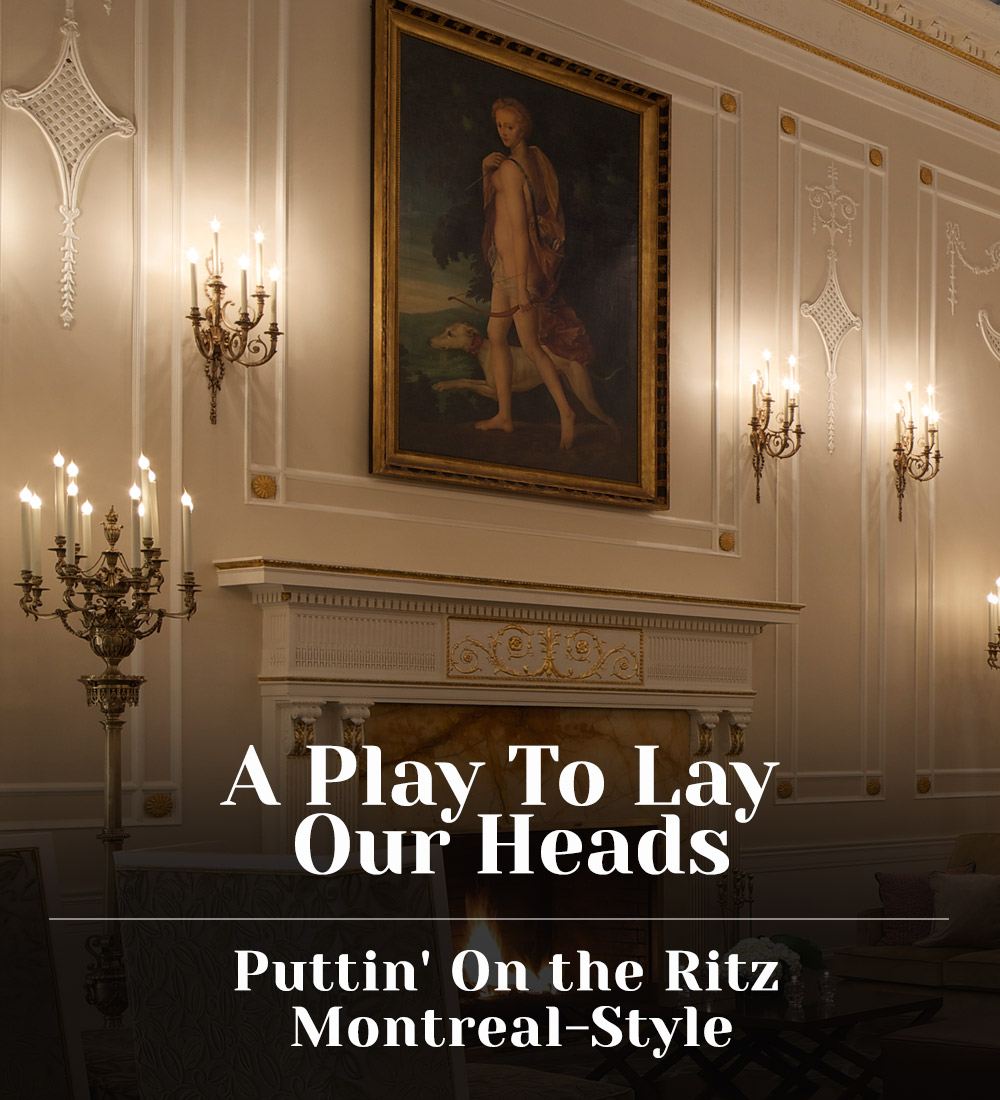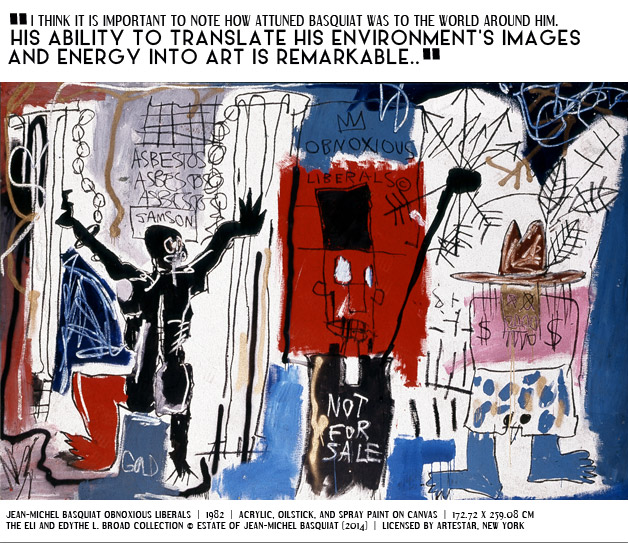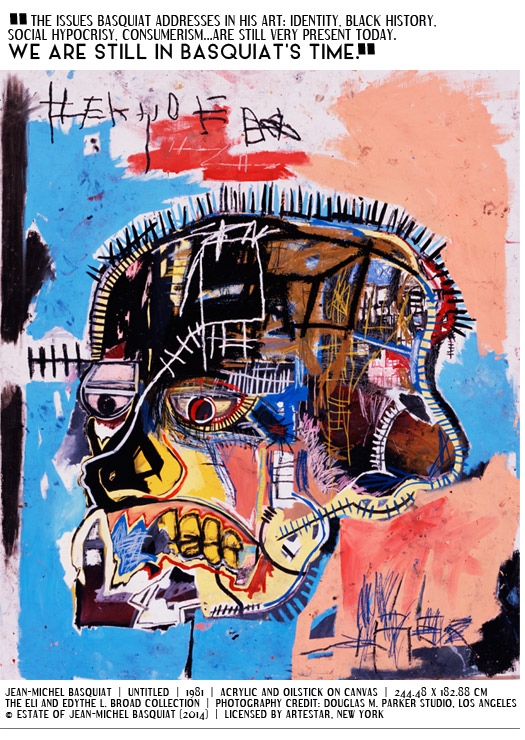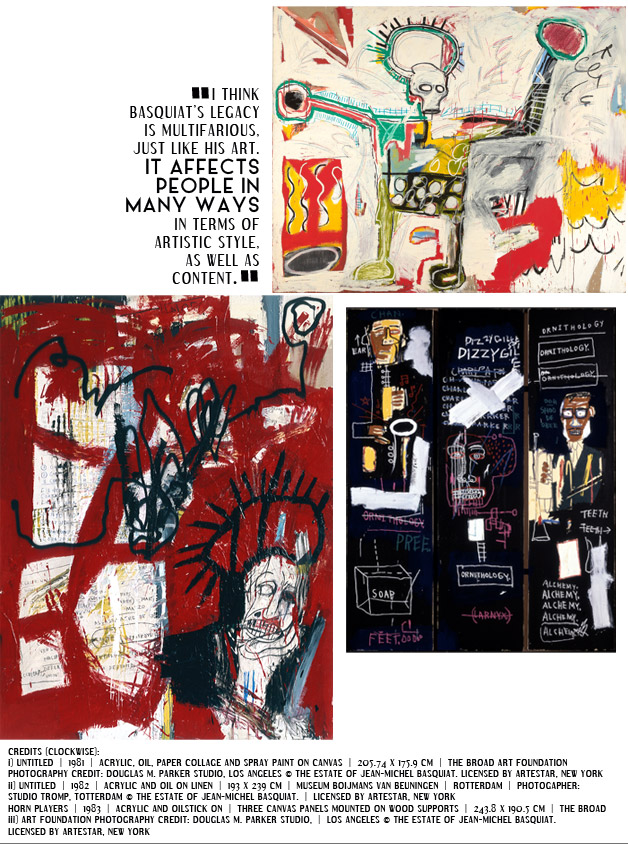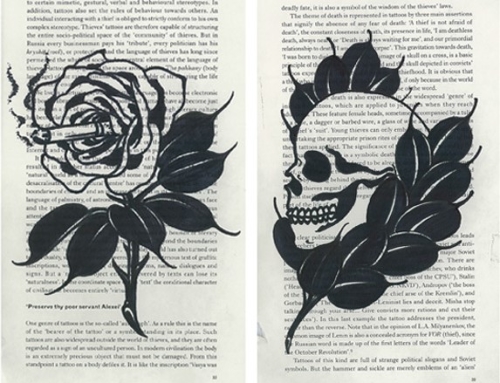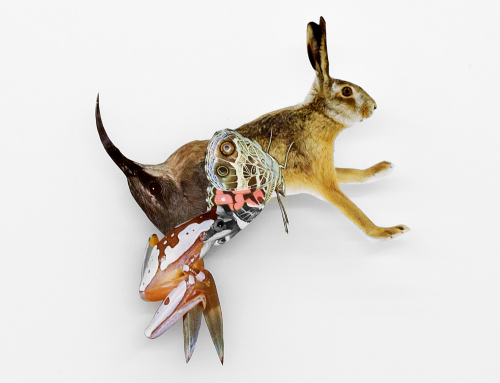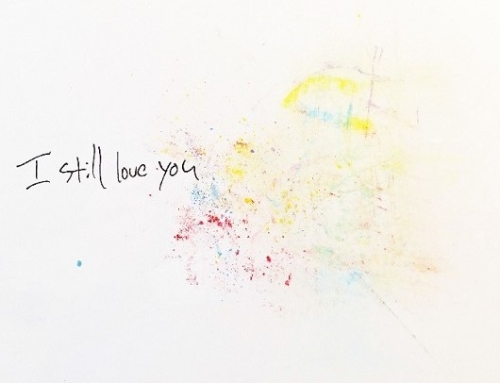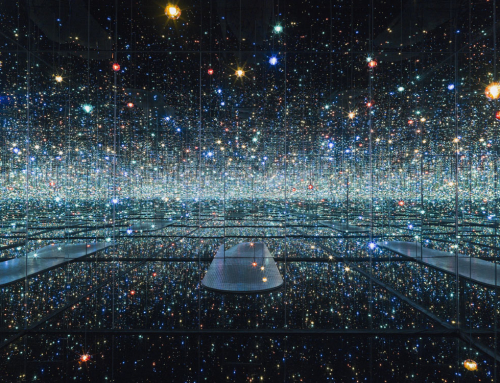Text by Jennifer Lee
Jean-Michel Basquiat has famously been quoted as saying, “I don’t think about art when I’m working. I try to think about life.” In the brief 8 years that were Basquiat’s artistic career, the native New Yorker examined “life”—people, ideology, conflicts, history—peeling away layer after layer, until the core of what might be deemed “truth” was unfurled and lay ready to be translated into shrewd brush strokes.
For Dieter Buchhart—the curatorial force behind the Art Gallery of Ontario’s (AGO) ongoing exhibition, “Jean-Michel Basquiat: Now’s the Time”—the artist “wielded his brush as a weapon,” and worked as a social force against those things in “life” that society accepts simply as the status quo.
“Basquiat dedicated himself with great intensity to struggles against capitalism, inequality and racism.” writes Buchhart in his essay, “Against All Odds” for the exhibit’s catalog. “His powerful denouncements of hierarchy and rules were inspired by cartoons, children’s drawings, advertising and Pop art, and by Aztec, African, Greek, Roman and everyday culture.”
Nearly thirty years after the 27-year-old artist’s untimely death, the “everyday culture” Basquiat chose as his subject, is still sensitive to the artist’s observations and censure. “He’s illustrating histories in a way, and were still in those histories,” says Madalyn Asimakis, the exhibition’s Curatorial Assistant.
The artistic spirit of 1980s New York, Basquiat’s legacy as one who paints with the authority of the Zeitgeist itself, is restated through the 85 paintings and works on paper that comprise “Now’s the Time”—notably, the first major Basquiat retrospective in Canada, and the largest in North America since the Brooklyn Museum’s exhibit in the spring of 2005.
Works, such as “Defacement (The Death of Michael Stewart),” act as exacting annotations, penetrating the root of social phenomenon too long sanctioned by defective ideologies and systemic cultural complacency. Basquiat’s incisive response to the brutal beating and consequential death of 25-year-old graffiti artist Michael Stewart by New York City police in 1983, “Defacement” and it’s central themes—racism, anger, injustice, frustration—can only too easily be reinterpreted to integrate the August 9, 2014 shooting of 18-year-old Michael Brown. Killed by Darren Wilson, a white police officer in Ferguson, Missouri, a grand jury chose not to indict Wilson for killing the unarmed black teenager that following November. Similarly, “Defacement,” could, yet again, be said to mirror the death of another black male, 43-year-old Eric Garner, during an attempted arrest by NYPD officers, just one month prior to the Ferguson shooting. In this instance, it was the use of a chokehold that proved lethal. Like Brown’s case, the grand jury—this time in Staten Island, N.Y.—decided not to pursue charges against the officers responsible for the death of the unarmed husband and father of six. “It’s the identical issue, 30 years later,” comments Asimakis, who adds that she was working on the Michael Stewart panel the day of the grand jury announcement in the Garner case. “It was one of the multiple shocking moments, where the overlap was alarming.”
On display at the AGO until May 10th—the exhibition’s only North America stop on its international tour—“Jean-Michel Basquiat: Now’s the Time” is a must-see for Basquiat lovers and observers of cultural studies alike. (Let’s not forget, this is a man at the center of ‘80s Pop culture, with the likes of Madonna, David Bowie and of course, Andy Warhol making up his inner circle of friends.) Sharing her insight into the artist’s works and the exhibit’s themes, Magdalyn Asimakis takes a moment to speak with us about the life and times of Jean-Michel Basquiat.

You must have been extremely immersed in Basquiat’s world and art while preparing for this exhibit; now that you’ve had a chance to step back and enjoy the exhibit, what are your impressions of the end product? Do you feel like the team at the AGO accomplished what they set out to do with this exhibit?
I definitely found myself immersed in Basquiat’s world for the last year; it is a world of constant discovery. We’re thrilled to have so many strong works in our exhibition that exemplify prominent themes in Basquiat’s art. There are many recurring themes in Basquiat’s works, which is what we based the exhibition themes on, and I think this exhibition presents them in a way that will allow visitors to understand Basquiat’s art and the issues he was interested in on a deeper level.
What was it like working with Dieter Buchhart on this exhibit? He’s quite the expert on the artist. What was his vision and how did he tailor it with the AGO team?
Dieter’s vision was something that the AGO was very enthusiastic about, which was to create a Basquiat exhibition that is focused on the content of Basquiat’s paintings. This can be a challenge, as Basquiat doesn’t often reference one topic per painting. It was such a rich, and challenging, experience to explore the content of Basquiat’s works with Dieter, our community advisory group, and the AGO’s education department. The questions that lead our thinking were: what symbols and motifs recur in Basquiat’s work, which subject matter comes up again and again and what is the relevance; how does this work relate to our world today, to the present tense and to Toronto.
The exhibit feels very relevant to today and to the city, it strikes you right away, I think. Is there one painting of Basquiat’s from the exhibit that you would say exists as a key piece?
There are certainly a lot of Basquiat’s masterpieces in the exhibit. “Now is the Time” is central, that work has so much meaning to it. Basquiat loved Charlie Parker because he identified with him as a black artist pushing limits, he admired his experimental approach. The work’s title also references Martin Luther King’s 1963, “I Have a Dream” speech, and its call to action. The title asks you to look at the here and now, to examine and reflect. It’s not only about Basquiat’s time, it’s about our time.
Basquiat’s visual language is famed for being provocative; we’ve already talked a bit about themes, but would you say one central theme of the exhibit could be how the artist pushed cultural and artistic boundaries?
The central theme in “Jean-Michel Basquiat: Now’s the Time” is how Basquiat translated the world around him into a groundbreaking visual language that challenged, and continues to challenge, viewers’ assumptions about the world around them. The exhibition is organized according to recurring themes in the artist’s work. Basquiat pushed artistic boundaries in both the style and in the content of his work.
Agreed. When walking through the exhibit, you really get a sense of the period and the time in which the artist was working, but it also feels like his works could be directly commenting on today’s contemporary culture and social issues. Is that what makes Basquiat’s work such a standout?
For sure that’s what makes his art so rich and sophisticated. The events [in his paintings] took place before his time, in his time and after his time.
With decades having passed since Basquiat’s paintings first took hold of the art world, what would you say his lasting legacy has been on the contemporary art scene and young artists working today?
I think Basquiat’s legacy is multifarious, just like his art. It affects people in many ways in terms of artistic style, as well as content. His work is filled with information! While his artistic style is certainly influential to many artists, I think it is also important to note how attuned he was to the world around him. His ability to translate his environment’s images and energy into art is remarkable.
His reach has been incredible too, and across so many disciplines too.
He created a whole new visual language. He fused knowledge and creativity, and paved the way for so many artists…not just painters, but fashion, music…
Do you believe that Basquiat’s work still has the power today to provoke social dialog and encourage the viewer to re-think the world around them?
The kind of conversation that has been happening in the space is astonishing. The issues Basquiat addresses in his art: identity, black history, social hypocrisy, consumerism…are still very present today. We are still in Basquiat’s time.
On that note, of the works on display, which seems to speak strongest to gallery visitors? Which painting or drawing do you imagine will become a favourite out of all the exhibit works?
Each work in the exhibitions is unique, both aesthetically and in terms of content, which is a great because hopefully each visitor will find one that they really connect with. From my experience so far, I have noticed many people are attracted to “The Death of Michael Stewart.” It is a smaller work which hangs opposite Basquiat’s self-portrait. I think this work resonates with a lot of people because the story still has such a sense of immediacy. The painting depicts a black sarcophagus-like figure being hit by two police officers with batons. The story is based on a true event: Basquiat’s friend Michael Stewart was a graffiti artist, who was beaten to death by transit police. He was 25-years-old. Basquiat, also a young black male in 1980s New York, knew this fate could have just as easily been his own. Unfortunately, these crimes are still occurring today, which is why I think this painting has had so much impact.
That piece really does demands the gallery-goers attention. I understand the AGO is the only North American stop on the exhibit’s tour…pretty exciting, no?
Considered by our Director and CEO Matthew Teitelbaum to be an extraordinarily compelling and important figure of late 20th century art, Basquiat has been on the AGO’s radar for many years. When Matthew saw an opportunity last year to collaborate with curator Dieter Buchhart, widely considered to be one of the world’s most knowledgeable Basquiat experts, he seized it.







